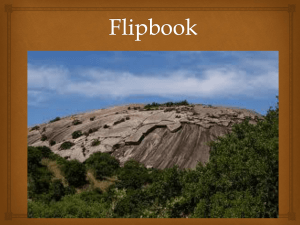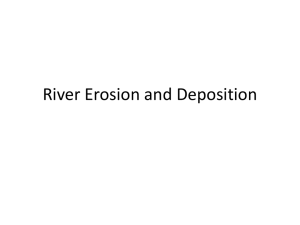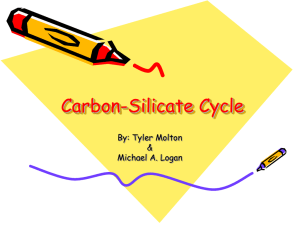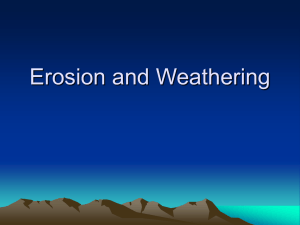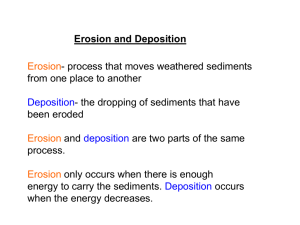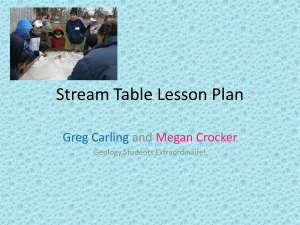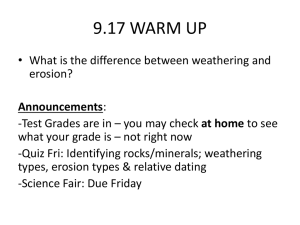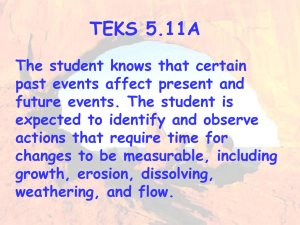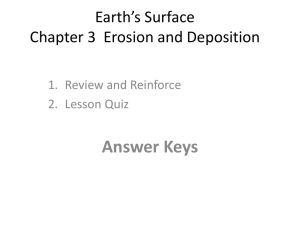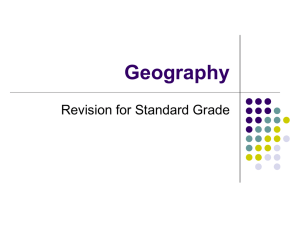erosion only - Sarasota Schools
advertisement
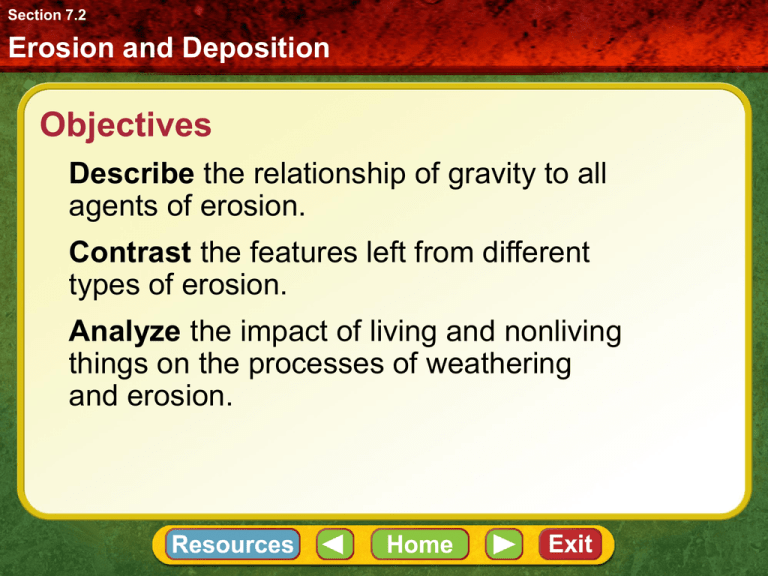
Section 7.2 Erosion and Deposition Objectives Describe the relationship of gravity to all agents of erosion. Contrast the features left from different types of erosion. Analyze the impact of living and nonliving things on the processes of weathering and erosion. CH 7 Study Guide Key Concepts Section 7.2 Erosion and Deposition Erosion transports weathered materials across Earth’s surface until they are deposited. The processes of erosion and deposition have shaped Earth’s landscape in many ways. CH 7 Study Guide Key Concepts Section 7.2 Erosion and Deposition Gravity is the driving force behind major agents of erosion. Agents of erosion include running water, waves, glaciers, wind, and living things. Section 7.2 Erosion and Deposition New Vocabulary erosion rill erosion deposition gully erosion Section 7.2 Erosion and Deposition Gravity’s Role The removal of weathered rock and soil from its original location is a process called erosion. Erosion can remove material through a number of different agents, including running water, glaciers, wind, ocean currents, and waves. Section 7.2 Erosion and Deposition Gravity’s Role After the rock and soil are transported, sometimes thousands of kilometers away from their source, they are dropped in another location in a process known as deposition. Section 7.2 Erosion and Deposition Gravity’s Role Gravity is associated with many erosional agents because the force of gravity tends to pull all materials downslope. Section 7.2 Erosion and Deposition Erosion by Water Stream erosion can reshape entire landscapes. Water flowing down steep slopes has additional erosive potential resulting from gravity, causing it to cut downward into the slopes, carving steep valleys and carrying away rock and soil. • Dead Horse Point Overlook, with the Colorado River flowing 2,000 feet below. 300 million years of erosion has carved the expansive canyons, cliffs and walls below and surrounding Deadhorse Point. River eroding volcanic ash flow Alaska Southwest, Valley of Ten Thousand Smokes • Horseshoe Bend. The Colorado River makes a 180-degree turn at Horseshoe Bend. Here the river has eroded the Navaho sandstone for eons, digging a canyon 1100-feet deep . Section 7.2 Erosion and Deposition Erosion by Water Rill erosion develops when running water cuts small channels into the side of a slope. When a channel becomes deep and wide, rill erosion evolves into gully erosion. Section 7.2 Erosion and Deposition Erosion by Water Rivers and streams Once a river enters the ocean, the current slows down, which reduces the potential of the stream to carry sediment. As a result, rivers deposit large amounts of sediment near the region where they enter the ocean. Over time, deltas form. Section 7.2 Erosion and Deposition Erosion by Water Wave action The work of ocean currents, waves, and tides carves out cliffs, arches, and other features along the continents’ edges. • The Mississippi River Delta, showing the sediment plumes from the Mississippi and Atchafalaya Riltaic Rivers. Section 7.2 Erosion and Deposition Erosion by Water Wave action The constant movement of water and the availability of accumulated weathered material result in a continuous erosional process. Deposition of sand particles forms features such as beaches and sandbars; erosion removes sand from these features. • Waves pounding at Venus Bay, South Africa • Wave cut platform caused by erosion of cliffs by the sea at Southerndown in South Wales Section 7.2 Erosion and Deposition Glacial Erosion Because glaciers can move as dense, enormous rivers of slowly flowing ice, they have the capacity to carry huge rocks and piles of debris over great distances and grind the rocks beneath them into flour-sized particles. • V Shaped Valley from Glacial Erosion • Tallus slope Section 7.2 Erosion and Deposition Glacial Erosion The features left in the wake of glaciers include steep U-shaped valleys and lakes. • Iceberg Lake Section 7.2 Erosion and Deposition Glacial Erosion The effects of glaciers on the landscape also include deposition. For example, soils in the northern parts of the United States are formed from material that was transported and deposited by glaciers. • Rolling terrain as a result of glaciers • As the glacier moves, the rocks on the bottom move across the land. • “plucked” land from a glacier Section 7.2 Erosion and Deposition Wind Erosion Wind can be a major erosional agent, especially in arid and coastal regions, which tend to have little vegetation to hold soil in place. Wind can easily pick up and move fine, dry particles. • Rock formation in Bolivia • Moab Alcove Section 7.2 Erosion and Deposition Wind Erosion The abrasive action of windblown particles can damage both natural features and human-made structures. Winds can also easily move fine-grained sediments and sand uphill. • Mt. Rushmore Section 7.2 Erosion and Deposition Erosion by Living Things As plants and animals carry out their life processes, they often move Earth’s surface materials from one place to another. • Dirt bikes caused the erosion in this picture.
